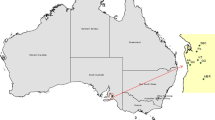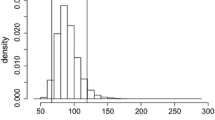Summary
A harmonic or Fourier analysis of mean monthly rainfall data is found useful in objectively describing and mapping the seasonality of rainfall within Australia. Over large areas the seasonal component is well described by the first and second harmonic terms, leaving as a residual variance only a small proportion of the observed total variance. Care must be taken in the interpretation of second harmonic contributions within those areas of tropical Australia under strong monsoonal influences. This is because pecularities in the form of the annual rainfall regime make the first harmonic term inadequate in itself to fully describe the annual trend. The technique is found particularly useful in defining the boundaries of areas of similar seasonality, and maps based upon the first and second harmonic amplitudes are shown to bear a close relationship with known physical controls.
Zusammenfassung
Zur objektiven Beschreibung der jahreszeitlichen Schwankung der Regenfälle in Australien und ihrer kartenmäßigen Darstellung wird mit Erfolg die harmonische Analyse der mittleren Monatsmengen des Niederschlags angewendet. Über weiten Gebieten wird die jahreszeitliche Schwankung durch die ersten beiden harmonischen Schwingungen gut dargestellt; die Reststreuung macht nur einen kleinen Bruchteil der beobachteten Gesamtstreuung aus. Vorsicht erscheint jedoch geboten bei der Interpretation des Anteils der zweiten Harmonischen in den Gebieten des tropischen Australien, die unter starkem Monsuneinfluß stehen. Hier machen Besonderheiten im Niederschlagsregime selbst die erste Harmonische ungenügend zur Beschreibung des Jahresganges. Die angewandte Methode ist besonders geeignet, die Grenzen zwischen Gebieten mit gleichartigem Jahreszeiteneinfluß festzulegen. Karten, die auf der ersten und zweiten harmonischen Schwingung beruhen, zeigen einen engen Zusammenhang mit bekannten physikalischen Faktoren.
Résumé
Afin de décrire objectivement les variations saisonnières des précipitations en Australie, on se sert avantageusement de l'analyse harmonique des sommes mensuelles moyennes. Cette méthode est également utilisée pour la représentation cartographique des dites variations. Les amplitudes saisonnières sont bien rendues par les deux premières harmoniques et cela pour de grandes étendues. L'amplitude qui reste ne représente qu'une faible fraction de l'amplitude totale observée. Il faut cependant procéder avec prudence lors de l'interprétation de la part revenant à la seconde harmonique dans les contrées tropicales de l'Australie, contrées qui subissent fortement l'influence de la mousson. Dans ce cas précis, les particularités du régime des précipitations ne permettent même pas d'utiliser la première harmonique pour décrire l'évolution des pluies au cours de l'année. La méthode proposée est surtout intéressante pour délimiter les régions soumises aux mêmes régimes. Des cartes basées sur la première et la seconde harmonique montrent un rapport étroit entre les précipitations et certains facteurs physiques connus.
Similar content being viewed by others
References
Andrews, J., andW. H. Maze: Some Climatological Aspects of Aridity in their Application to Australia. Proc. Linnean Soc. N. S. W.58, 105 to 124 (1933).
Brooks, C. E. P., andN. Carruthers: Handbook of Statistical Methods in Meteorology. London: H. M. Stationery Office. 1953.
Christian, C. S., andG. A. Stewart: General Report on Survey of Katherine-Darwin Region, 1946. C. S. I. R. O. Aust. Land Res. Ser. No. 1; 27–31 (1953).
Commonwealth Bureau of Meteorology: Climatic Averages, Australia (107 pp.). Melbourne; Commonwealth Bureau of Meteorology, 1956.
Conrad, V., andL. W. Pollak: Methods in Climatology. Cambridge, Mass.: Harvard Univ. Press. 1951.
Davidson, J.: Bioclimatic Zones in Australia. Trans. Roy. Soc. S. Aust.60, 88–92 (1936).
Horn, L. H., andR. A. Bryson: Harmonic Analysis of the Annual March of Precipitation Over the United States. Ann. Assoc. Amer. Geog.50, 157–171 (1960).
Prescott, J. A.: The Climate of Australia in Relation to Possible Agricultural Occupation. Trans. Roy. Soc. S. Aust.62 229–240 (1938).
Lawrence, E. F.: Climatic Regions in Tropical Australia. Aust. Geog.4, 20–26 (1941).
Sabbagh, M. A., andR. A. Bryson: Aspects of the Precipitation Climatology of Canada Investigated by the Method of Harmonic Analysis. Ann. Assoc. Amer. Geog.52, 426–440 (1962).
Slatyer, R. O.: Agricultural Climatology of the Katherine Area, N. T. C. S. I. R. O. Aust. Division of Land Research and Regional Survey Technical Paper No. 13 (1960).
Trumble, H. C.: Climatic Factors in Relation to the Agricultural Regions of Southern Australia. Trans. Roy. Soc. S. Aust.63, 36–43 (1939).
Author information
Authors and Affiliations
Additional information
With 9 Figures
Rights and permissions
About this article
Cite this article
Fitzpatrick, E.A. Seasonal distribution of rainfall in Australia analysed by Fourier methods. Arch. Met. Geoph. Biokl. B. 13, 270–286 (1964). https://doi.org/10.1007/BF02243257
Issue Date:
DOI: https://doi.org/10.1007/BF02243257




